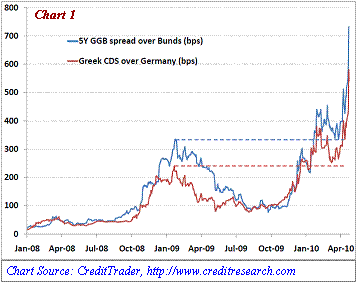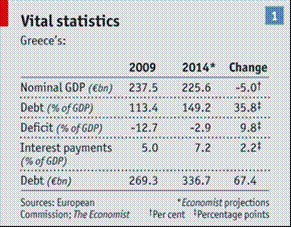Results 1 to 1 of 1
Thread: Greek Debt Crisis: Lehman 2.0?
Thread Information
Users Browsing this Thread
There are currently 1 users browsing this thread. (0 members and 1 guests)
-
04-26-2010, 07:02 AM #1Senior Member


- Join Date
- May 2007
- Location
- South West Florida (Behind friendly lines but still in Occupied Territory)
- Posts
- 117,696
Greek Debt Crisis: Lehman 2.0?
Greek Debt Crisis: Lehman 2.0?
Interest-Rates / Global Debt Crisis Apr 25, 2010 - 06:58 AM
By: Dian_L_Chu
As if Greece did not already have enough problems. The market was already jolted by the Goldman SEC case. Then, it was the cloud of volcanic ash from Iceland postponed a key meeting with European Union (EU) and International Monetary Fund (IMF) officials on aid for the country.
When the Officials from the EU and IMF finally launched a two-week talk on a Greek rescue package this Wednesday, it failed to calm the bond markets.
Slow Talk, Bond Rout & Downgrade

To make matters even worse, on Thursday, the European Union revised upward its estimate of Greece's 2009 deficit to 13.6% of gross domestic product (GDP) and may be revised to as high as 14.1%. On that news, ratings agency Moody's downgraded Greece's credit rating, the second time in five months.
With a string of bad news, a bond market rout eventually pushed two-year Greek government bond yields above 10% and forced 10-year yields near 9% on Thursday.
Credit default swaps on Greeceâs five-year bonds also surged to a record high of 577 (Chart 1). Meanwhile, the Greek curve remains steeply inverted with two-year yield higher than the 5-year bond, which indicates that the market sees significant near-term risks.
Temporary Liquidity Relief

At these levels, it is virtually impossible for the debt-strapped nation to meet its funding needs on the open market. This sharp jump in borrowing costs ultimately forced Greek government to formally request the joint EU-IMF rescue plan on Friday.
After two months of intense debate among European governments and market speculations, the joint IMF-EU Greek rescue package has finally been decided earlier this month. The size of the rescue package reportedly amounts to about â¬45bn ($60bn, £40bn), of which less than a third will come from the IMF.
The heavily indebted Greece needs to borrow some â¬54 billion this year and must refinance around â¬20 billion in April and May. Simple math could tell you this â¬45-billion bailout only helps avert a temporary liquidity crisis and would sustain Greece through this year at best.
Solvency Risk Remains
Calculations by The Economist suggest that even on optimistic assumptions, Greece will run up an extra â¬67 billion of debt by 2014, when its debt will peak at a scary 149% of GDP. (Table 1)
Greece underlying problems--flat growth, high debt load and interest costs--could take years to resolve. Additional rescue program(s) of at least an equivalent sum--or more--might be needed again in the next few years, depending on the progress of their austerity measures.
This means resorting to a âdebt restructureâJoin our efforts to Secure America's Borders and End Illegal Immigration by Joining ALIPAC's E-Mail Alerts network (CLICK HERE)


 LinkBack URL
LinkBack URL About LinkBacks
About LinkBacks




 Reply With Quote
Reply With Quote

Bill Melugin: Border Patrol Apprehends 2,000 Illegal Aliens in...
04-25-2024, 07:51 PM in illegal immigration News Stories & Reports